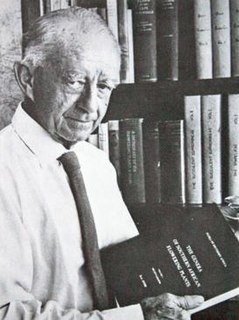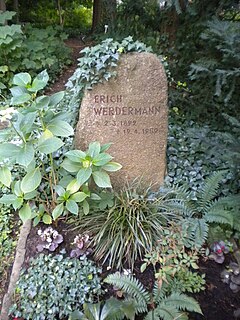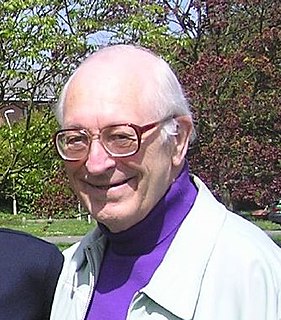Related Research Articles

Desert Botanical Garden is a 140-acre (57 ha) botanical garden located in Papago Park, at 1201 N. Galvin Parkway in Phoenix, central Arizona.

Bergerocactus emoryi is a species of cactus, known commonly as the golden-spined cereus, golden snake cactus, velvet cactus or golden club cactus. It is a relatively small cactus, but it can form dense thickets or colonies, with the dense yellow spines giving off a velvety appearance when backlit by the sun. From April to May, yellow, green-tinged flowers emerge, which transform into reddish, globular fruit. This species is native to the California Floristic Province, and is found in northwestern Baja California and a small part of California, in San Diego County and on the southern Channel Islands. Where the Mediterranean climate of the California Floristic Province collides with the subtropical Sonoran Desert near El Rosario, hybrids with two other species of cacti are found. It is the sole member of the monotypic genus Bergerocactus, named after German botanist Alwin Berger.

Ariocarpus is a small genus of succulent, subtropical plants of the family Cactaceae.

Parodia is a genus of flowering plants in the cactus family Cactaceae, native to the uplands of Argentina, Peru, Bolivia, Brazil, Colombia and Uruguay. This genus has about 50 species, many of which have been transferred from Eriocactus, Notocactus and Wigginsia. They range from small globose plants to 1 m (3 ft) tall columnar cacti. All are deeply ribbed and spiny, with single flowers at or near the crown. Some species produce offsets at the base. They are popular in cultivation, but must be grown indoors where temperatures fall below 10 °C (50 °F).

John Gilbert Baker FRS was an English botanist. His son was the botanist Edmund Gilbert Baker (1864–1949).
The Victoria Medal of Honour (VMH) is awarded to British horticulturists resident in the United Kingdom whom the Royal Horticultural Society Council considers deserving of special honour by the Society.

Echinocactus grusonii or Kroenleinia grusonii, popularly known as the golden barrel cactus, golden ball or mother-in-law's cushion, is a species of barrel cactus which is endemic to east-central Mexico.

Disocactus phyllanthoides, the nopalxochitl or German empress, is a species of flowering plant in the cactus family Cactaceae. It is commonly grown as an ornamental houseplant. It is one of the three major species involved in creating the widely grown epiphyllum hybrids or "epis". The others are Disocactus speciosus and Disocactus crenatus.

Robert Allen Dyer was a South African botanist and taxonomist, working particularly on Amaryllidaceae and succulent plants, contributing to and editing of Bothalia and Flowering Plants of Africa and holding the office of Director of the Botanical Research Institute in Pretoria from 1944 to 1963.
David Richard Hunt was an English botanist and taxonomist. He was a specialist in cacti and the spiderwort family. He notably compiled the 1999 CITES Cactaceae Checklist.

In botany, succulent plants, also known as succulents, are plants with parts that are thickened, fleshy, and engorged, usually to retain water in arid climates or soil conditions. It is a characteristic that is not used scientifically for the definition of most families and genera of plants because it often can be used as an accurate characteristic only at the single species level. The word succulent comes from the Latin word sucus, meaning 'juice', or 'sap'. Succulent plants may store water in various structures, such as leaves and stems. The water content of some succulent organs can get up to 90–95%. Some definitions also include roots, thus geophytes that survive unfavorable periods by dying back to underground storage organs may be regarded as succulents. In horticultural use, the term succulent is sometimes used in a way that excludes plants that botanists would regard as succulents, such as cacti. Succulents are often grown as ornamental plants because of their striking and unusual appearance, as well as their ability to thrive with relatively minimal care.

Erich Werdermann was a German botanist.
Karl Theodor Rümpler was a German botanist and horticulturist.
Edward Frederick Anderson was an American botanist who conducted extensive explorations in Mexico.
Anthony Julian Huxley was a British botanist. He edited Amateur Gardening from 1967 to 1971, and was vice-president of the Royal Horticultural Society in 1991.
Frederick James Chittenden (1873–1950) was a British horticulturalist and first Director of the Royal Horticultural Society (RHS) Wisley Garden. He was the author of a number of books on horticulture.

Harry Hall, was a British-born horticulturist, botanist and succulent plant authority.

Echinopsis subdenudata is a species of cactus. It has a globular shape, few spines, with large, white flowers attached to long, green tubes. It occurs in Bolivia, at altitudes of 600–1800 metres. Under its synonym Echinopsis ancistrophora it has gained the Royal Horticultural Society's Award of Garden Merit.
Ysabel Galbán Wright was a Cuban-American botanist and plant collector who specialized in cacti.

Gordon Douglas Rowley (1921–2019) was a British botanist and writer specialising in cacti and succulents.
References
- ↑ Hadfield, Miles; Harling, Robert; Highton, Leonie (1980). British Gardeners: A Biographical Dictionary. Zwemmer Books. p. 149. ISBN 9780302005415 . Retrieved 3 October 2018.
- ↑ "Obituary: Vera Higgins, M.A., F.L.S., V.M.H." Gardeners' Chronicle, Horticultural Trade Journal. Haymarket Publishing: 27. 1968. Retrieved 3 October 2018.
- ↑ Horwood, Catherine. Gardening Women: Their Stories From 1600 to the Present.
- 1 2 "Graptosedum 'Vera Higgins'". San Marcos Growers. Retrieved 3 March 2022.
- ↑ "Fellow Records". The Linnean Society. Retrieved 3 March 2022.
- ↑ Desmond, Ray (1994). Dictionary Of British And Irish Botanists And Horticulturists Including plant collectors, flower painters and garden designers. CRC Press. p. 340. ISBN 9780850668438 . Retrieved 3 October 2018.
- ↑ Foster, J.; Sheppard, J. (2016). British Archives: A Guide to Archive Resources in the UK. Springer. p. 437. ISBN 9781349652280 . Retrieved 3 October 2018.
- ↑ "Higgins, Vera (1892-1968) Botanist". discovery.nationalarchives.gov.uk. The National Archives. Retrieved 3 October 2018.
- ↑ IPNI. V.Higgins.